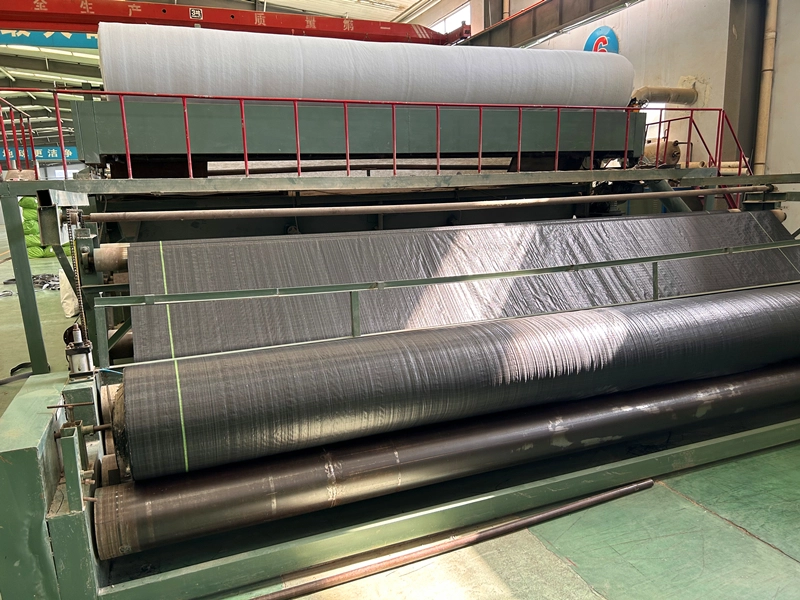
Haoyang's equipment for manufacturing composite geotechnical materials - bentonite waterproof blankets
Geotextiles offer multiple advantages in waste management, some of the major ones include:
1、Waste covering: Geotextiles can be used as covering materials for waste dumps to form a stable layer to prevent waste from scattering, weathering and negative impacts on the environment.
Geotextiles play an important role in waste coverage in waste management, and their specific performances include:
(1)Anti-penetration performance: As an anti-penetration material, geotextile can be used to cover landfills to prevent liquids in waste from penetrating into groundwater and reduce environmental pollution.
(2)Soil stability: Geotextiles can enhance the stability of the surface layer of waste and prevent it from being eroded by natural factors such as wind and rain, thereby maintaining the overall structure of the landfill.
(3)Covering layer protection: In waste storage areas, geotextiles serve as a protective layer that can slow down the loss and wear of the waste surface and extend the service life of the landfill.
(4)Gas Control: Geotextiles can also be used to control gases produced in waste, such as methane, helping to reduce greenhouse gas emissions and improve the environmental performance of landfills.
(5)Cover drainage: The permeable performance of geotextile helps to effectively drain water, prevent moisture from accumulating on the surface of waste during rainfall, and reduce the adverse impact on the landfill.
Through these multiple performances and advantages, geotextiles provide a reliable technical means for waste management, protect the environment, reduce contamination of groundwater, and improve the durability and sustainability of landfills.
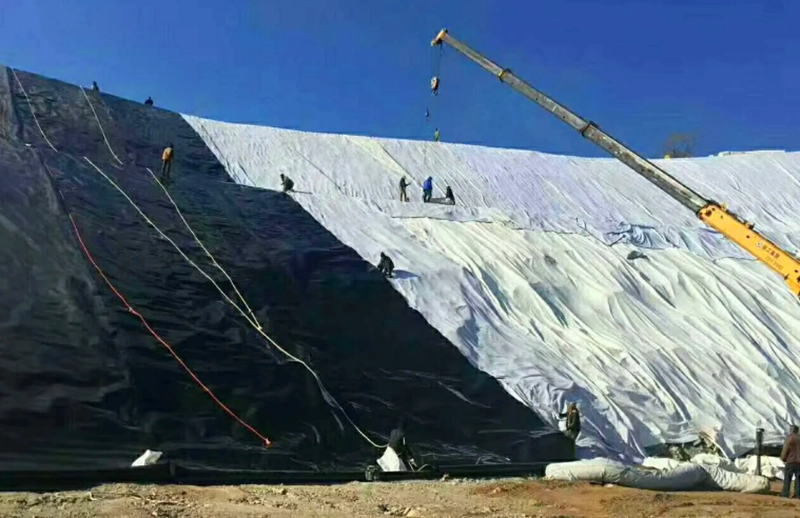
Haoyang Environmental Co., Ltd. is constructing on-site at the landfill site
2、Anti-penetration barrier: Geotextiles have anti-penetration properties and can be used to build anti-penetration barriers in waste landfills to prevent harmful substances from leaking into groundwater or soil, thereby protecting the surrounding environment.
The specific performance of geotextile as an anti-penetration barrier in waste management is as follows:
(1)Waterproof performance: Geotextile has good waterproof performance and can be used as an anti-permeability layer in waste landfills to prevent liquids in the garbage from penetrating into the ground and reduce groundwater pollution.
(2)Water Permeability: Despite its anti-penetration properties, geotextiles maintain a certain degree of water permeability, which aids in drainage and prevents moisture from accumulating on the surface of the landfill, reducing the water load on the site.
(3)Corrosion Resistance: Geotextiles are typically made from corrosion-resistant materials that can resist corrosive substances that may be present in the waste, ensuring that the barrier is effective for a long time.
(4)Mechanical strength: Geotextile has a certain mechanical strength and can withstand the pressure of waste landfill, maintain the integrity of the barrier, and prevent the formation of seepage channels.
(5)Flexibility: The flexibility and adaptability of geotextiles allows it to adapt to the shape of the landfill and surface irregularities, ensuring that the cover covers the entire landfill area.
Through the above multiple performances and advantages, geotextile as an anti-penetration barrier in waste management not only effectively prevents harmful substances from penetrating into groundwater, but also helps improve the environmental performance and sustainability of landfills.
3、Soil reinforcement: When establishing a landfill, geotextiles can be combined with other materials for soil reinforcement to improve the stability and load-bearing capacity of the landfill.
In waste management, the specific performance of geotextiles in soil reinforcement is as follows:
(1)Anti-erosion performance: Geotextiles can be used to reinforce slopes or soil surfaces to improve the anti-erosion performance of the soil. In waste sites, rainwater erosion or slope erosion may occur. The use of geotextiles can effectively slow down the soil erosion process and enhance the stability of the slope.
(2)Landslide resistance: Geotextiles can be used as a means of soil reinforcement to improve the landslide resistance of soil slopes. In landfill sites, due to the accumulation of waste, there may be problems with soil slope instability. Geotextiles can help prevent landslide events by enhancing the shear resistance of the soil.
(3)Dispersed load: Geotextile can disperse horizontal and vertical loads, reduce the stress concentration of the soil, and improve the overall stability of the soil. This plays an important role in preventing soil subsidence or deformation in waste sites.
(4)Anti-penetration: As an anti-penetration barrier, geotextile can also play a role in soil reinforcement. By being placed in the soil, it can prevent water penetration and maintain the stability of the soil.
(5)Corrosion resistance: Geotextiles are usually made of corrosion-resistant materials and can resist corrosive substances that may be present in waste, ensuring the long-term stability of the reinforced structure.
Through the above multiple performances and advantages, geotextiles are not only used as anti-penetration barriers in waste management, but also improve the overall stability and safety of landfill sites by reinforcing the soil.
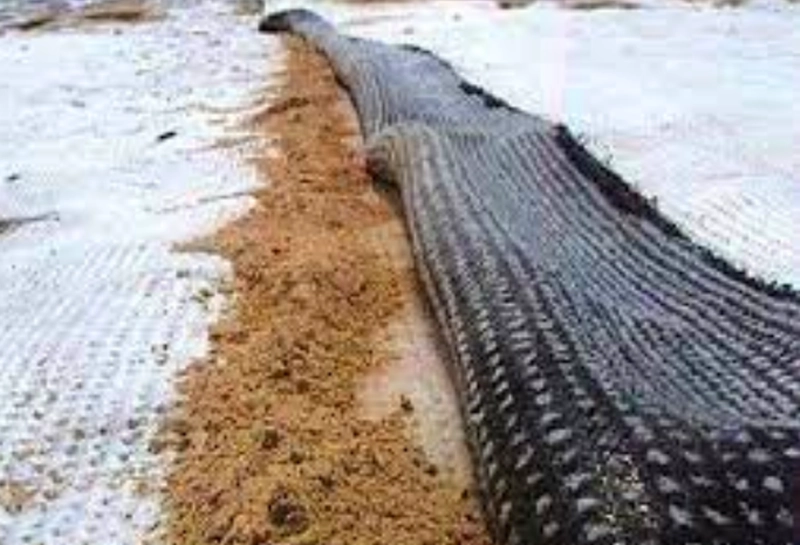
Treatment of combined soil and geotechnical materials at the landfill site by Haoyang Environmental Joint Stock Company
4、Waste separation: Geotextiles can be used to separate different types or stages of waste, helping to manage and control the flow of waste in landfills and reduce cross-contamination.
In waste management, the specific performance of geotextiles in waste separation is as follows:
(1)Separating different materials: Geotextiles can be used to separate different types or types of waste, preventing them from mixing together. This helps manage and handle waste of varying nature and reduces possible contamination or reactions.
(2)Controlling the spread of waste: Waste sites can have problems with the spread of waste, especially liquid waste. By using geotextile as an isolation layer, the spread of waste can be effectively controlled and pollution of the surrounding environment can be avoided.
(3)Improve landfill efficiency: Geotextile serves as a separation layer and can improve landfill efficiency during the landfill process. It helps maintain the hierarchical structure of different wastes, making landfill more orderly and conducive to full utilization of land.
(4)Prevent cross-infection: In medical waste management, geotextiles can be used to separate different categories of medical waste, prevent the occurrence of cross-infection, and ensure the safe disposal of waste.
(5)Reduce environmental impact: Geotextiles act as a separation layer to help reduce the impact of waste on soil and groundwater. It prevents waste from penetrating deep into the soil and reduces the risk of contamination of groundwater.
Through the above multiple performances and advantages, geotextiles play an important role in waste management as a waste separation layer, helping to improve management efficiency, reduce environmental impact, and ensure that waste is processed safely and orderly.
5、Steep slope protection: In the slope or intersection area of the landfill, geotextiles can be used in slope protection projects to prevent slope collapse and erosion.
In waste management, the specific performance of geotextiles in steep slope protection is as follows:
Suppressing lateral erosion: Steep slopes are prone to lateral erosion. Geotextiles can be used as slope protection materials to cover the surface of steep slopes, effectively inhibiting the erosion and erosion of the slope by water flow, and protecting the stability of the slope.
(1)Improve slope stability: Geotextiles improve the stability of the overall slope by increasing the erosion and erosion resistance of the steep slope surface. It can prevent the slope from collapsing and sliding due to water erosion.
(2)Promote vegetation growth: Geotextile can be used as a support layer for vegetation cover, which helps the growth of vegetation. By providing a stable foundation, plants can more easily take root on steep slopes, thereby enhancing the slope protection effect.
(3)Prevent soil erosion: Steep slopes are prone to soil erosion. Geotextiles form a protective layer that can effectively prevent soil particles from being washed away by water and slow down the erosion rate.
(4)Reduced maintenance costs: Compared with traditional concrete structures, geotextile construction is relatively simple and maintenance costs are low. At the same time, geotextiles can adapt to harsh environmental conditions and have a long service life.
Through these specific performances and advantages, geotextiles play an important role in steep slope protection in waste management, maintaining the stability of steep slopes and reducing environmental risks.
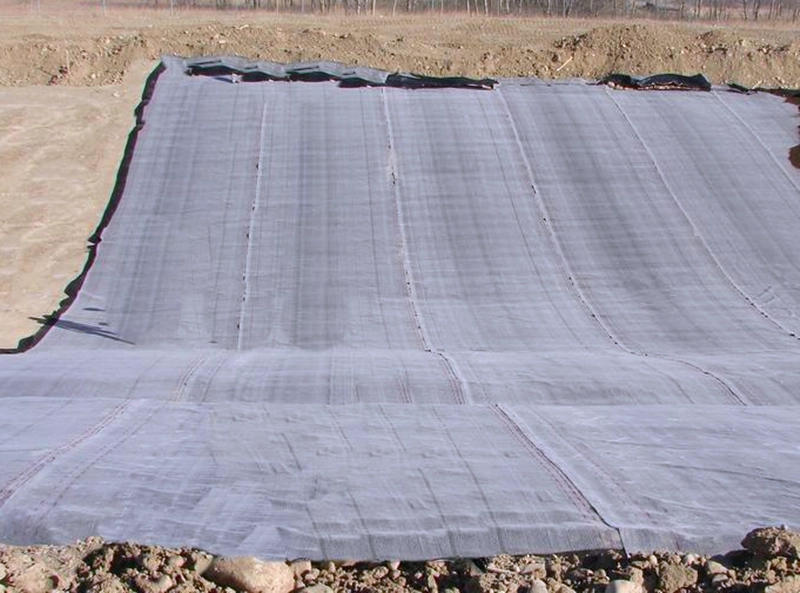
The company is at the processing site where the landfill is protected from steep slopes
6、Gas emission control: Geotextiles can be used in gas control systems in waste landfills to help manage and reduce harmful gas emissions.
In waste management, the specific performance of geotextiles in gas emission control is as follows:
(1)Waste Containment Covering: Geotextiles can be used for containment coverage of waste dump sites. By covering the surface of the waste with geotextile, gas emissions on the surface of the waste can be effectively prevented. This helps control the spread of harmful gases such as methane in the waste.
(2)Gas discharge channel design: Geotextiles can be used to design gas discharge channels to ensure that the discharged gas can be effectively collected and treated. This design can reduce the impact on the surrounding environment and reduce the spread of harmful gases.
(3)Ventilation hole settings: When using geotextiles in waste dumps, vent holes can be set so that the gas generated in the waste can be discharged in an orderly manner. This can control the emission speed of gas and slow down the spread of harmful gases.
(4)Blocking the diffusion of chemical substances: Geotextiles have good barrier properties and can effectively block the diffusion of chemical substances. This is particularly important for waste management sites where harmful gases or volatile chemicals may be produced.
(5)Stable gas discharge channel: Geotextile, as the bottom covering or gas discharge channel material, can provide a relatively stable channel structure and help maintain the shape and stability of the gas discharge channel.
Through these measures and advantages, geotextiles can effectively control gas emissions in waste management, reduce negative impacts on the environment, and protect the health of the surrounding ecosystem.
7、Environmental protection: By using geotextiles, the risk of contamination of surrounding soil and water bodies by waste landfills can be reduced, and it can help maintain the health of the surrounding ecological environment.
The environmental protection performance of geotextiles in waste management mainly includes the following aspects:
(1)Waste covering layer: Geotextile can be used as a covering layer for waste dumps, effectively covering the surface of the waste and reducing the spillage of harmful substances in the waste. This helps prevent rainwater infiltration and reduces the formation of leachate, thereby reducing the risk of contamination of soil and groundwater.
(2)Anti-penetration barrier: As a type of anti-penetration barrier, geotextile can prevent harmful substances in waste from penetrating into groundwater through the soil. This helps maintain groundwater quality and reduces groundwater contamination.
(3)Land Stability Reinforcement: In the design of waste dumps, geotextiles can be used to improve land stability. By reinforcing slopes and protecting side slopes, geotextiles help slow down land erosion and collapse and maintain the overall stability of the yard.
(4)Gas emission control: The use of geotextiles can design reasonable gas emission channels to control the emission of harmful gases generated in waste. This helps reduce the impact of waste on surrounding air quality and protects the atmospheric environment.
(5)Reduce waste leachate generation: Leachate in waste is a liquid that may contain harmful substances. By using geotextiles, rainwater infiltration can be reduced, thereby reducing leachate production. This has a positive effect in reducing negative impacts on groundwater and soil.
Through these environmental protection measures and advantages, geotextiles play an important role in waste management, helping to minimize adverse effects on the surrounding environment and achieve safe disposal and environmentally friendly management of waste.
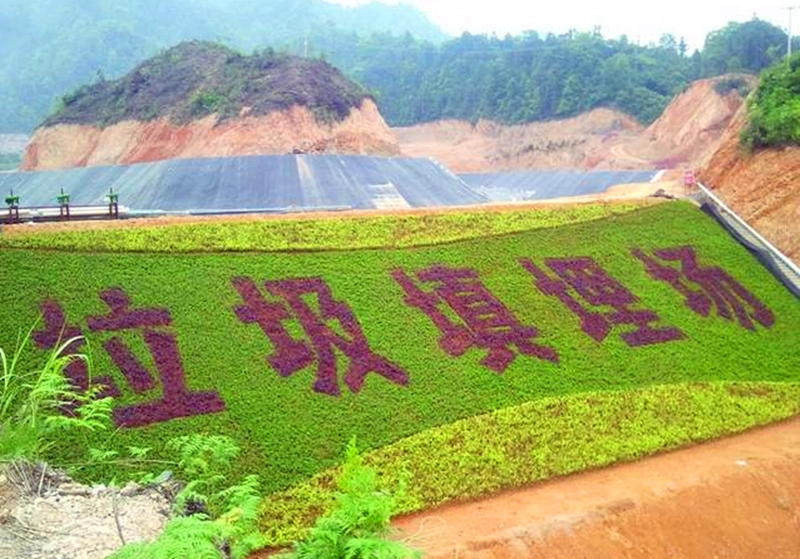
A case study of greening measures after the landfill is capped
8、Construction efficiency improvement: The use of geotextiles can improve the construction efficiency of landfills and reduce project time and costs.
The construction efficiency improvement of geotextiles in waste management is mainly reflected in the following aspects:
(1)Quick installation: The large width and light weight of geotextiles allow for rapid installation in waste dumps. This can save manpower and time and improve project construction efficiency.
(2)On-site customization: Geotextiles can often be customized on-site to the shape and requirements of a specific site. This customized performance allows geotextiles to better adapt to complex terrain and irregularly shaped waste sites, reduce waste and improve construction efficiency.
(3)Simple connection method: Geotextiles usually use simple connection methods, such as hot melt or mechanical connection. These connection methods are not only simple and easy to implement, but can also increase the connection speed, reduce the complexity of construction, and improve efficiency.
(4)Reduce labor intensity: Due to the lightweight characteristics of geotextiles, construction workers have lower labor intensity during handling and laying. This helps reduce workers' burden and improve work efficiency.
(5)Flexibility: The flexibility of geotextile makes it suitable for waste sites of different shapes and topography. Compared with traditional materials, geotextiles are easier to adjust and adapt, improving construction flexibility.
Generally speaking, the construction efficiency improvement of geotextile in waste management is reflected in its convenient, fast and flexible characteristics, which provides convenient conditions for the smooth progress of the project.
Taken together, the biggest advantage of geotextiles offer in waste management is its versatility, which can be used in many aspects of waste landfills to protect the environment, improve the stability and safety of landfills, and reduce operational costs. and maintenance costs.
![]() 300g PET geotextiles test report.pdf
300g PET geotextiles test report.pdf
![]() 200g Staple fiber non-woven geotextile.pdf
200g Staple fiber non-woven geotextile.pdf
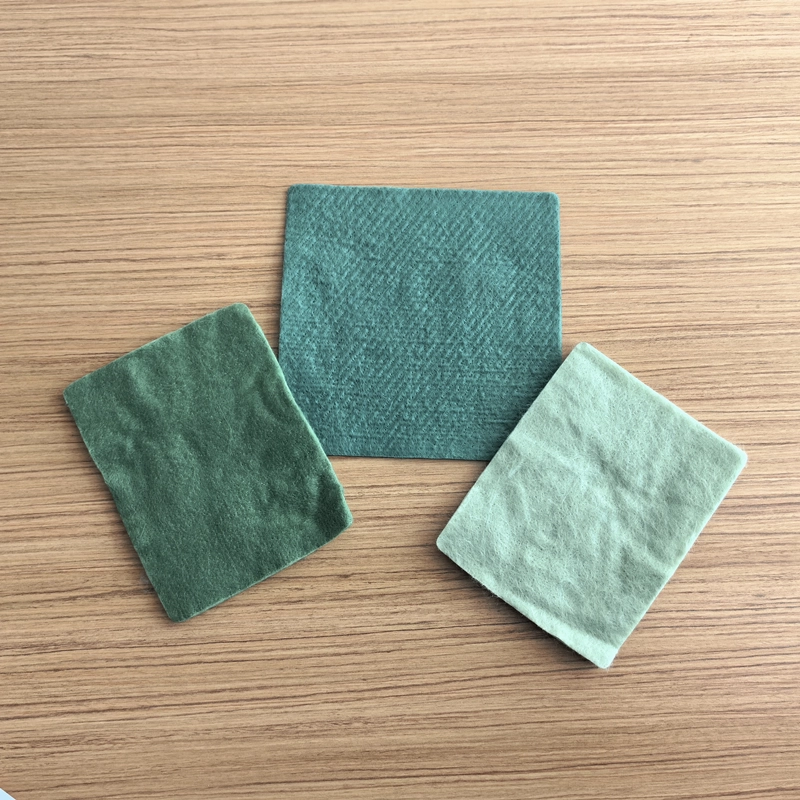

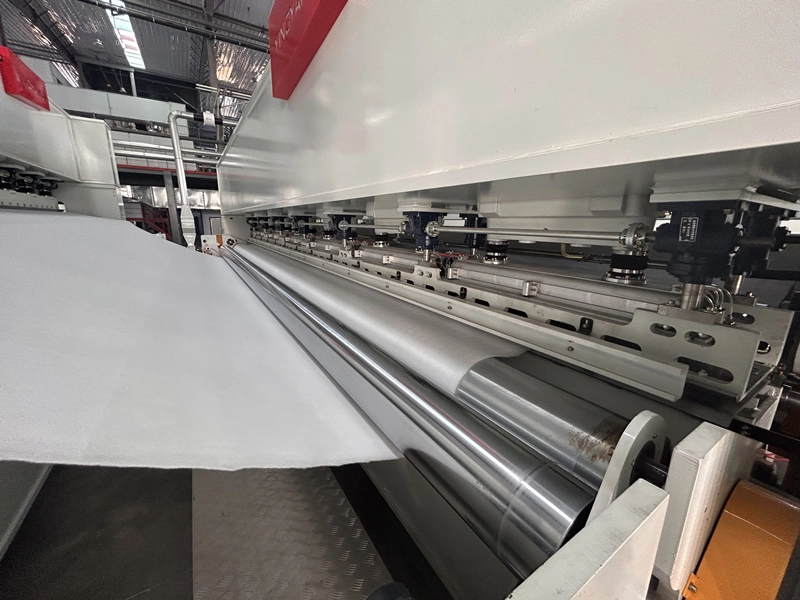

503.webp)
759.webp)
241.webp)
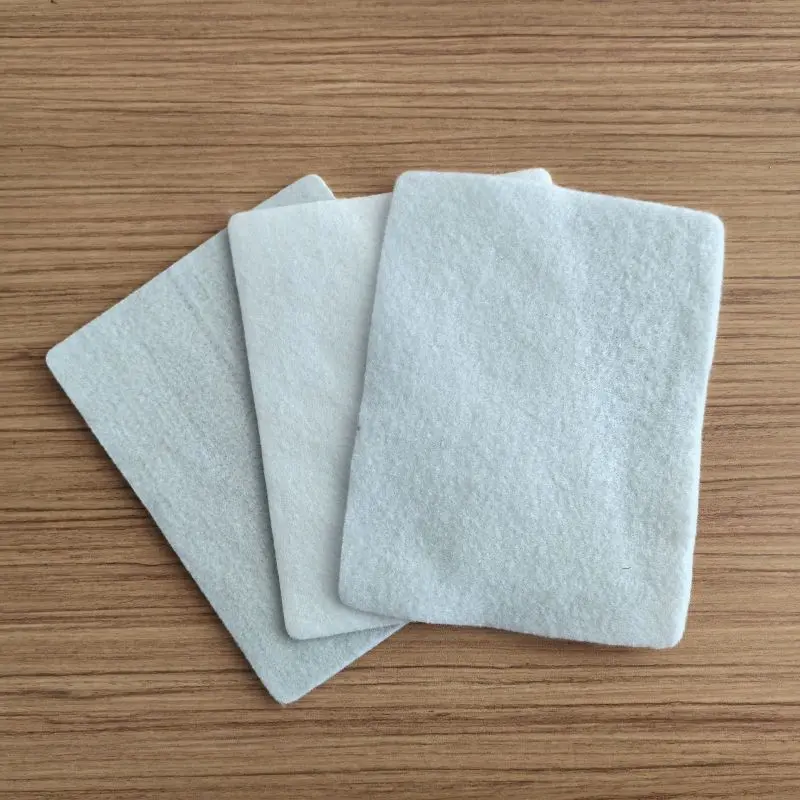
191.webp)